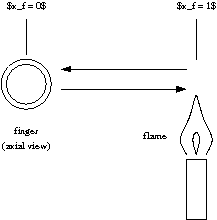Exercise: Moving your finger through a flame without getting burned
(Contributed by Demetri Spanos, 3 Oct 04)
In this problem we will look at how to play with fire without getting burned. The system we want to consider is a finger being moved back and forth across a flame, as shown below:

The description of the system is as follows:
The temperature of a finger is regulated by an internal feedback mechanism. To first order, we will say that heat is convected away by blood flow, at a rate

where
 is the temperature of the fingertip,
is the temperature of the fingertip,
 is the temperature of the blood, and
is the temperature of the blood, and
 is the convection coefficient (the
is the convection coefficient (the  signifies the heat flux).
signifies the heat flux).
A flame gives off heat into the ambient air, and we assume steady-state temperature field around the flame. The ambient air far from the flame is at
 degrees Celsius.
degrees Celsius.
The flame is fixed at
 , and fingertip begins
at a position
, and fingertip begins
at a position  , where the ambient air is precisely at
the same temperature as the blood.
, where the ambient air is precisely at
the same temperature as the blood.
Suppose that the temperature of the air varies exponentially with distance from the flame, so

where
 is the flame temperature.
is the flame temperature.
Heat convects into the finger from the ambient air at a rate

The dynamics of the fingertip temperature is given by

where
 is the fingertip thermal capacity.
is the fingertip thermal capacity.
The fingertip is rapidly passed into and out of the flame, according to

Using the MATLAB ode45 function (or something similar), build a model for the system and solve the following:
Assume that the finger moves sinusoidally in and out of the flame at frequency
 rad/sec. Plot the temperature of the finger as a
function of time and identify the transient and steady state response.
rad/sec. Plot the temperature of the finger as a
function of time and identify the transient and steady state response.
Plot the steady state amplitude of the finger temperature as a function of the
 for
for  ranging from 1 to 100 rad/sec. You
should get something similar to the frequency response plot shown in
lecture on Monday. You should compute at least 5 points in your graph.
ranging from 1 to 100 rad/sec. You
should get something similar to the frequency response plot shown in
lecture on Monday. You should compute at least 5 points in your graph.
Double the "gain" of the temperature control system by increasing
 by a factor of 2. Replot the frequency response from
part~b and describe in words how it differs from the
original gain (i.e., where is the response bigger, smaller or unchanged
and what is the reason).
by a factor of 2. Replot the frequency response from
part~b and describe in words how it differs from the
original gain (i.e., where is the response bigger, smaller or unchanged
and what is the reason).
You should use the following parameter values in your simulations:
 ,
,  degrees Celsius.
degrees Celsius.

